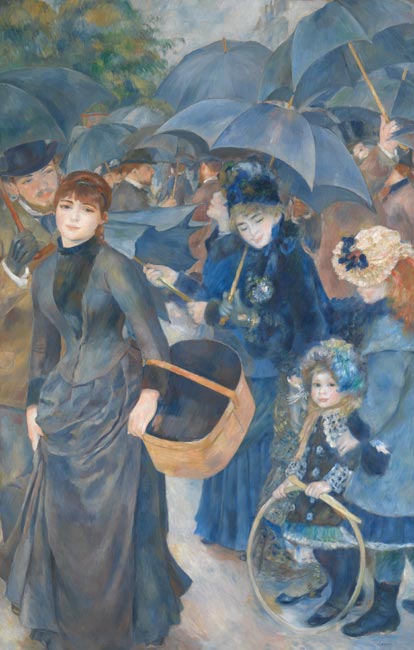
Pierre-Auguste Renoir, “The Umbrellas (Les Parapluies),” oil on canvas, ca. 1881-85 (courtesy the National Gallery, London)
The Frick Collection
1 East 70th St. at Fifth Ave.
Tuesday – Sunday through May 13, $18 (pay-what-you-wish Sunday 11:00 am – 1:00 pm)
212-288-0700
www.frick.org
The Frick takes a unique approach to the work of French artist Pierre-Auguste Renoir in the small but delightful exhibition “Renoir, Impressionism, and Full-Length Painting.” For the first time ever, nine large-scale figurative Renoir paintings have been brought together from around the world and displayed in the Frick’s East Gallery, which has never before been dedicated to a single show; in addition, it is a one-time-only event, as the Frick will be its only home. Inspired by the Paris Salons of the 1870s and 1880s, Renoir created several long, rectangular canvases that celebrated French fashion and style. Renoir favors solitary figures in “The Dancer,” “La Parisienne,” and “Madame Henriot ‘en travesti’ (The Page),” concentrating on the subjects’ dress, the first two set against an Impressionistic background. In the Frick’s own “La Promenade,” a mother guides her two young daughters through the park, all three elegantly attired amid lush blues and greens. On one wall, an 1883 trilogy of works that focus on dancing couples hang side by side. In “Dance in the City,” a formally dressed man and woman dance demurely, his right hand gently grasping the middle of her back, her gloved left hand placed delicately on his right shoulder. In “Dance in the Country,” a more casually dressed couple seems to be having more fun, the man gazing lovingly at the woman, the woman smiling at the viewer; a straw hat lying in the lower right corner adds to the simplicity and genuineness of the moment. And in “Dance at Bougival,” the most intimate and sensual of the three, the man and woman hold on to each other with bare hands as people in the background chatter on, with glasses of beer on a table and cigarette butts littering the ground. Seen together, the works form a dramatic triptych of love, romance, and class structure in late-nineteenth-century Paris. The most surprising piece in the exhibition is “The Umbrellas (Les Parapluies),” a complex canvas dominated by a woman carrying a picnic basket in the left foreground and facing the viewer, a group of open umbrellas at the top extending deep into the background. A man gazes upon the woman, perhaps about to offer her some cover, while a little girl holding a hoop looks at the viewer from the lower right. The subjects’ faces and the geometric patterns of the umbrellas, the basket, the hoop, and various hats battle for attention in this sharply painted scene. The show also delves into Renoir’s use of models as well as how some of the works changed over time, as revealed by close inspection and x-ray technology. Organized by Frick deputy director Colin B. Bailey, “Renoir, Impressionism, and Full-Length Painting” is a lovely examination of Renoir’s own artistic dance with size.